Financial Sustainability of Selected Rain Water Harvesting Systems for Single-Family House under Conditions of Eastern Poland
Abstract
:1. Introduction
2. Materials and Methods
3. Results and Discussion
4. Conclusions
- The performed financial assessment of the proposed RWH designs showed that their economical sustainability under the local conditions is in most of the cases questionable; local investors would not obtain the cash incomes or savings expected as result of their investment.
- The determined cost of ecological effect, i.e., the total discounted cost of 1 m3 of harvested and stored or reused water for domestic demands rain, was only in two cases lower than the similar cost of tap water supplied by municipal water distribution system.
- The profitability of the proposed RWH designs under the economic conditions of Eastern Poland is very low, as in most cases both the applied benefits–costs indicators, NPV and BCR, were below the profitability threshold, and only the application of additional savings resulting from avoiding the stormwater fee in 50% of the studied designs allowed to exceed the threshold.
- The application of variable, modern, up-to-date technologies and equipment of RWH frequently may cause a decrease in the design profitability, due to the high investment as well as O&M costs, thus, such designs may not be selected by local investors.
- The increase in profitability of RWH design is highly affected by cash savings, so the replacement of the highest volume possible of tap water by rain water in a wide variety of domestic applications is strongly advised.
- The outside partial refund of investment costs, without the assigned monetary value limit, should be available to increase the profitability of the RWH designs, thus, to increase their financial attractiveness, required for the local population’s acceptance.
Author Contributions
Funding
Conflicts of Interest
References
- Arfanuzzaman, M.; Rahman, A.A. Sustainable water demand management in the face of rapid urbanization and ground water depletion for social—Ecological resilience building. Glob. Ecol. Conserv. 2017, 10, 9–22. [Google Scholar] [CrossRef]
- Roser, M.; Ritchie, H.; Ortiz-Ospina, E. World Population Growth. 2019. Available online: https://ourworldindata.org/world-population-growth (accessed on 5 May 2020).
- Nagypál, V.; Mikó, E.; Hodúr, C. Sustainable Water Use Considering Three Hungarian Dairy Farms. Sustainability 2020, 12, 3145. [Google Scholar] [CrossRef] [Green Version]
- Özerol, G.; Dolman, N.; Bormann, H.; Bressers, H.; Lulofs, K.; Böge, M. Urban water management and climate change adaptation: A self-assessment study by seven midsize cities in the North Sea Region. Sustain. Cities Soc. 2020, 55, 102066. [Google Scholar] [CrossRef]
- Report of the World Commission on Environment and Development: Our Common Future. 1987. Available online: https://sustainabledevelopment.un.org/content/documents/5987our-common-future.pdf (accessed on 5 May 2020).
- Kärrman, E. Strategies towards sustainable wastewater management. Urban Water 2001, 3, 63–72. [Google Scholar] [CrossRef]
- Mihelcic, J.; Crittenden, J.; Small, M.; Shonnard, D.; Hokanson, D.; Zhang, Q.; Chen, H.; Sorby, S.A.; James, V.U.; Sutherland, J.W.; et al. Sustainability science and engineering: The emergence of a new metadiscipline. Environ. Sci. Technol. 2003, 37, 5314–5324. [Google Scholar] [CrossRef] [PubMed]
- Caparrós-Martínez, J.L.; Rueda-Lópe, N.; Milán-García, J.; De Pablo, J. Public policies for sustainability and water security: The case of Almeria (Spain). Glob. Ecol. Conserv. 2020, 23, e01037. [Google Scholar] [CrossRef]
- Garrick, D.; Iseman, T.; Gilson, G.; Brozovic, N.; O’Donnel, E.; Matthews, N.; Miralles-Wilhelm, F.; Wight, C.; Young, W. Scalable solutions to freshwater scarcity: Advancing theories of change to incentivize sustainable water use. Water Res. 2020, 9, 100055. [Google Scholar] [CrossRef]
- Yang, T.H.; Liu, W.C. A General Overview of the Risk-Reduction Strategies for Floods and Droughts. Sustainability 2020, 12, 2687. [Google Scholar] [CrossRef] [Green Version]
- European Environmental Agency. 2019. Available online: https://www.eea.europa.eu/pl/sygna142y/sygnaly-2018/artykuly/zuzycie-wody-w-europie-2014 (accessed on 5 May 2020).
- Palme, U.; Lundin, M.; Tillman, A.M.; Molander, S. Sustainable development indicators for wastewater systems—Researchers and indicator users in a co-operative case study. Resour. Conserv. Recycl. 2005, 43, 293–311. [Google Scholar] [CrossRef] [Green Version]
- Mariolakos, I. Water resources management in the framework of sustainable development. Desalination 2007, 213, 147–151. [Google Scholar] [CrossRef]
- Othman, S.N.; Noor, Z.Z.; Abba, A.H.; Yusuf, R.O. Review of life cycle assessment of integrated solid waste management in some Asian countries. J. Clean. Prod. 2013, 43, 251–262. [Google Scholar] [CrossRef]
- Garcia, M.; Koebele, E.; Deslatte, A.; Ernst, K.; Manago, K.F.; Treuer, G. Towards urban water sustainability: Analyzing management transitions in Miami, Las Vegas, and Los Angeles. Glob. Environ. Chang. 2019, 58, 101967. [Google Scholar] [CrossRef]
- Maurya, S.P.; Singh, P.K.; Ohri, A.; Singh, R. Identification of indicators for sustainable urban water development planning. Ecol. Indic. 2020, 108, 105691. [Google Scholar] [CrossRef]
- Witkowski. 2018. Available online: https://www.researchgate.net/publication/325896310_Paradoksy_swiatowej_gospodarki_wodnej_Paradoxes_of_the_world_water_management (accessed on 5 May 2020).
- Suleiman, L.; Olofsson, B.; Saurí, D.; Palau-Rof, L. A breakthrough in urban rain-harvesting schemes through planning for urban greening: Case studies from Stockholm and Barcelona. Urban For. Urban Gree. 2020, 126678. [Google Scholar] [CrossRef]
- Mourad, K.A.; Berndtsson, J.C.; Berndtsson, R. Potential fresh water saving using greywater in toilet flushing in Syria. J. Environ. Manag. 2011, 92, 2447–2453. [Google Scholar] [CrossRef]
- Silva, C.M.; Sousa, V.; Carvalho, N.V. Evaluation of rainwater harvesting in Portugal: Application to single-family residences. Resour. Conserv. Recycl. 2015, 94, 21–34. [Google Scholar] [CrossRef]
- Sepehri, M.; Malekinezehad, H.; Ilderomi, A.R.; Talebi, A.; Hosseini, S.Z. Studying the effect of rain water harvesting from roof surfaces on runoff and household consumption reduction. Sustain. Cities Soc. 2018, 43, 317–324. [Google Scholar] [CrossRef]
- Dz, U. Regulation of the Minister of Infrastructure of 14 January 2002 Regarding the Determination of Average Standards for Water Consumption. 2002 No. 8, Item 70; ISAP, 2002. Available online: http://prawo.sejm.gov.pl/isap.nsf/DocDetails.xsp?id=WDU20020080070 (accessed on 5 May 2020).
- GUS. Available online: https://stat.gov.pl/ (accessed on 5 May 2020).
- Meville-Shreeve, P.; Ward, S.; Butler, D. Rainwater harvesting Typologies for UK houses: A multi criteria analysis of system configurations. Water 2016, 8, 129. [Google Scholar] [CrossRef] [Green Version]
- Soonthornnonda, P.; Christensen, E.R. Source apportionment of pollutants and flows of combined sewer wastewater. Water Res. 2008, 42, 1889–1998. [Google Scholar] [CrossRef]
- Park, M.-H.; Swamikannu, X.; Stenstrom, M.K. Accurancy and precision of the volume-concentration method for urban stormwater modeling. Water Res. 2009, 43, 2773–2786. [Google Scholar] [CrossRef]
- Oviedo-Ocaña, A.R.; Dominguez, I.; Ward, S.; Rivera-Sanchez, M.L.; Zaraza-Peña, J.M. Financial feasibility of end-user designed rainwater harvesting and greywater reuse systems for high water use households. Environ. Sci. Pollut. Res. 2018, 25, 19200–19216. [Google Scholar] [CrossRef] [PubMed] [Green Version]
- Burns, M.J.; Fletcher, T.D.; Duncan, H.P.; Hatt, B.E.; Ladson, A.R.; Walsh, C.J. The performance of rainwater tanks for stormwater retention and water supply at the household scale: An empirical study. Hydrol. Process. 2015, 29, 152–160. [Google Scholar] [CrossRef]
- Xu, W.D.; Fletcher, T.D.; Duncan, H.P.; Bergmann, D.J.; Breman, J.; Burns, M.J. Improving the Multi-Objective Performance of Rainwater Harvesting Systems Using Real-Time Control Technology. Water 2018, 10, 147. [Google Scholar] [CrossRef] [Green Version]
- Musayev, S.; Burgess, E.; Mellor, J. A global performance assessment of rainwater harvesting under climate change. Resour. Conserv. Recycl. 2018, 132, 62–70. [Google Scholar] [CrossRef]
- Alamdari, N.; Sample, D.J.; Liu, J.; Ross, A. Assessing climate change impacts on the reliability of rainwater harvesting systems. Resour. Conserv. Recycl. 2018, 132, 179–189. [Google Scholar] [CrossRef]
- European Commission. Study on Water Performance of Buildings. Reference Report 070307/2008/520703/ETU/D2; European Commision (DG ENV): Paris, France, 2009. [Google Scholar]
- Campisano, A.; Gnecco, I.; Modica, C.; Palla, A. Designing domestic rainwater harvesting systems under different climatic regimes in Italy. Water Sci. Technol. 2013, 67, 2511–2518. [Google Scholar] [CrossRef]
- Amos, C.C.; Rahman, A.; Gathenya, J.M. Economic Analysis and Feasibility of Rainwater Harvesting Systems in Urban and Peri-Urban Environments: A Review of the Global Situation with a Special Focus on Australia and Kenya. Water 2016, 8, 149. [Google Scholar] [CrossRef]
- Gnecco, I.; Palla, A.; La Barbera, P. The role of domestic rainwater harvesting systems in storm water runoff mitigation. Eur. Water 2017, 58, 497–503. Available online: https://www.ewra.net/ew/pdf/EW_2017_58_72.pdf (accessed on 5 May 2020).
- Cook, S.; Sharma, A.; Chong, M. Performance analysis of a communal residential rainwater system for potable supply: A case study in Brisbane, Australia. Water Resour. Manag. 2013, 27, 4865–4876. [Google Scholar] [CrossRef]
- Campisano, A.; Butler, D.; Ward, S.; Burns, M.J.; Friedler, E.; DeBusk, K.; Fisher-Jeffes, L.N.; Ghisi, E.; Rahman, A.; Furumai, H. Urban rainwater harvesting systems: Research, implementation and future perspectives. Water Res. 2017, 115, 192–209. [Google Scholar] [CrossRef]
- Lazarova, V.; Hills, S.; Birks, R. Using recycled water for non-potable, urban uses: A review with particular reference to toilet flushing. Water Sci. Technol. Water Supply 2003, 3, 69–77. [Google Scholar] [CrossRef]
- GhaffarianHoseini, A.; Tookey, J.; GhaffarianHoseini, A.; Yusoff, S.M.; Hassan, N.B. State of the art of rainwater harvesting systems towards promoting green built environments: A review. Desalin. Water Treat. 2016, 57, 95–104. [Google Scholar] [CrossRef]
- Gardner, T.; Vieritz, A. The role of rainwater tanks in Australia in the twenty first century. Archit. Sci. Rev. 2010, 53, 107–125. [Google Scholar] [CrossRef]
- Petrucci, G.; Deroubaix, J.F.; de Gouvello, B.; Deitsch, J.C.; Bompard, P.; Tassin, B. Rainwater harvesting to control stormwater runoff in suburban areas. An experimental case-study. Urban Water J. 2012, 9, 45–55. [Google Scholar] [CrossRef] [Green Version]
- Zhang, X.; Hu, M.; Chen, G.; Xu, Y. Urban rainwater utilization and its role in mitigating urban water logging problems: A case study in Nanjing, China. Water Resour. Manag. 2012, 26, 3757–3766. [Google Scholar] [CrossRef]
- Campisano, A.; Modica, C. Appropriate resolution timescale to evaluate water saving and retention potential of rainwater harvesting for toilet flushing in single houses. J. Hydroinform. 2015, 17, 331–344. [Google Scholar] [CrossRef] [Green Version]
- Harris, J.M.; Wise, T.A.; Gallagher, K.P.; Goodwin, N.R. Book Review: A Survey of Sustainable Development: Social and Economic Dimensions. Environ. Pract. 2001, 3, 263–264. [Google Scholar] [CrossRef]
- Harding, R. Ecologically sustainable development: Origins, implementation and challenge. Desalination 2006, 187, 229–239. [Google Scholar] [CrossRef]
- Kwangware, J.; Mayo, A.; Hoko, Z. Sustainability of donor-founded rural water supply and sanitation projects in Mbire district, Zimbabwe. Phys. Chem. Earth 2014, 76–78, 134–139. [Google Scholar] [CrossRef]
- Frone, S.; Frone, D.F. Emerging markets Queries in Finance and Business. Economic risk to a regional water supply and sanitation project in Romania. Procedia Econ. Financ. 2015, 32, 550–557. [Google Scholar] [CrossRef] [Green Version]
- Ellis, J.B.; Deutch, J.C.; Mouchel, J.M.; Scholes, L.; Revitt, M.D. Multicriteria decision approaches to support sustainable drainage options for the treatment of highway and urban runoff. Sci. Total Environ. 2004, 334–335, 251–260. [Google Scholar] [CrossRef] [PubMed]
- Ugwu, O.O.; Kumaraswamy, M.M.; Wong, A.; Ng, S.T. Sustainability appraisal in infrastructure projects (SUSAIP): Part 1. Development of indicators and computational methods. Autom. Constr. 2006, 15, 239–251. [Google Scholar] [CrossRef]
- United Nations Indicators of Sustainable Development: Guidelines and Methodologies, 3rd ed.; United Nations, Department of Economic and Social Affairs: New York, NY, USA, 2007.
- Mateo, J.R.S.C. Weighted Sum Method and Weighted Product Method. Multi Criteria Analysis in the Renewable Energy Industry; Springer: London, UK, 2012; pp. 19–22. [Google Scholar]
- Chourabi, Z.; Khedher, F.; Babay, A.; Cheikhrouhou, M. Multi-criteria decision making in workforce choice using AHP, WSM and WPM. J. Text. Inst. 2019, 110, 1092–1101. [Google Scholar] [CrossRef]
- Widomski, M.; Gleń, P.; Łagód, G.; Jaromin-Gleń, K. Sustainable development of one of the poorest province of the European Union: Lublin Voivodeship, Poland—Attempt of assessment. Probl. Ekorozw. 2015, 10, 137–149. Available online: https://ekorozwoj.pollub.pl/index.php/number-1022015/sustainable-development-of-one-of-the-poorest-province-of-the-european-union-lublin-voivodeship-poland-attempt-of-assessment/ (accessed on 5 May 2020).
- Lorenc, H. Atlas Klimatu Polski (Atlas of Polish Climate); Instytut Meteorologii i Gospodarki Wodnej: Warszawa, Poland, 2005. [Google Scholar]
- PN-EN 12056-3. Gravity Sewage Systems inside Buildings, Part 3: Rain Pipes, Layout Design and Calculations; PKN: Poland, 2002. [Google Scholar]
- PN-EN 1717. Protection against Secondary Pollution in Plumbing and General Requirements for Devices to Prevent Backflow Pollution; PKN: Poland, 2003. [Google Scholar]
- PN-EN 806-3. Specifications for Installations inside Buildings Conveying Water for Human Consumption, Part 3: Pipe Sizing—Simplified Method; PKN: Poland, 2006. [Google Scholar]
- DIN 1989-1:2001-10. Rainwater Harvesting Systems—Part 1: Planning, Installation, Operation and Maintenance; German Institute for Standardisation: Berlin, Germany, 2001. [Google Scholar]
- DIN 1989-2:2004-08. Rainwater Harvesting Systems—Part 2: Filters; German Institute for Standardisation: Berlin, Germany, 2004. [Google Scholar] [CrossRef]
- Mishan, E.J.; Quah, E. Cost-Benefit Analysis; Praeger: New York, NY, USA, 1976. [Google Scholar]
- Griffin, R.C. The fundamental principles of cost-benefit analysis. Water Resour. Res. 1998, 34, 2063–2071. Available online: http://ron-griffin.tamu.edu/agec636/readings/files/GriffinCBA1998.pdf (accessed on 5 May 2020). [CrossRef]
- Weingartner, H.M. Some New Views on the Payback Period and Capital Budgeting Decisions. Manag. Sci. 1969, 15. [Google Scholar] [CrossRef]
- Boardman, C.M.; Reinhart, W.J.; Celec, S.E. The role of the payback period in the theory and application of duration to capital budgeting. JBFA 1982. [Google Scholar] [CrossRef]
- Rączka, J. The cost-effectiveness analysis—A superior alternative to the cost-benefit analysis of environmental infrastructure investments. In Proceedings of the Fifth European Conference on Evaluation of the Structural Funds “Challenges for Evaluation in an Enlarged Europe”, Budapest, Hungary, 26–27 June 2003. [Google Scholar]
- Widomski, M.K.; Ładziak, E.; Łagód, G. Economic aspects of sustainable sanitation in rural settlements. ACCE 2017, 10, 153–162. Available online: http://acee-journal.pl (accessed on 5 May 2020). [CrossRef] [Green Version]
- Tuominen, P.; Reda, F.; Dawoud, W.; Elboshy, B.; Elshafei, G.; Negm, A. Economic Appraisal of Energy Efficiency in Buildings Using Cost-effectiveness Assessment. Procedia Econ. Financ. 2015, 21, 422–430. [Google Scholar] [CrossRef] [Green Version]
- Berry, K.; Charnley, G.; Eberstadt, N.; Glantz, M.; Loewen, E.; Moore, T.; Opie, J.; Rutherford, F.; Seitz, F.; Sedjo, R.; et al. Environmental Economics Volume 1: The Essentials; Environmental Literacy Council: Washington, DC, USA, 2007. [Google Scholar]
- Elmaghraby, S.E.; Herroelen, W.S. The scheduling of activities to maximize the net present value of projects. EJOR 1990, 49, 35–49. [Google Scholar] [CrossRef]
- Remer, D.S.; Nieto, A.P. A compendium and comparison of 25 project evaluation techniques. Part 1: Net present value and rate of return methods. Int. J. Prod. Econ. 1995, 42, 79–96. [Google Scholar] [CrossRef]
- McEwan, P.J. Cost-effectiveness analysis of education and health interventions in developing countries. J. Dev. Eff. 2012, 4, 189–213. [Google Scholar] [CrossRef] [Green Version]
- Locatelli, L.; Guerrero, M.; Russo, B.; Martínez-Gomariz, E.; Sunyer, D.; Martínez, M. Socio-Economic Assessment of Green Infrastructure for Climate Change Adaptation in the Context of Urban Drainage Planning. Sustainability 2020, 12, 3792. [Google Scholar] [CrossRef]
- McPherson, E.G.; Simpson, J.R.; Peper, P.J.; Gardner, S.L.; Vargas, K.E.; Xiao, Q. Northeast Community Tree Guide: Benefits, Costs, and Strategic Planting; Gen. Tech. Rep. PSW-GTR-202; U.S. Department of Agriculture, Forest Service, Pacific Southwest Research Station: Albany, CA, USA, 2010; p. 106. [CrossRef]
- Coleman, A.; Grimes, A. Betterment taxes, capital gains and benefit cost ratios. Econ. Lett. 2010, 109, 54–56. [Google Scholar] [CrossRef]
- Benzerra, A.; Cherrared, M.; Chocat, B.; Cherqui, F.; Zekiok, T. Decision support for sustainable urban drainage system management: A case study of Jijel, Algieria. J. Environ. Manag. 2012, 101, 46–53. [Google Scholar] [CrossRef] [PubMed]
- Lewicka, A.; Widmski, M.K.; Łagód, G. Economic analyses in sewage system designing for rural settlements—Case study. ACCE 2016, 2, 145–152. Available online: https://www.exeley.com/architecture_civil_engineering_environment/doi/10.21307/acee-2016-030 (accessed on 5 May 2020). [CrossRef] [Green Version]
- City of Białystok. Available online: https://www.bialystok.pl/pl/dla_mieszkancow/fundusze_unijne/realizowane/okresprogramowania20142020/zagospodarowanie-wod-deszczowych-poprzez-budowe-kanalizacji-deszczowej-i-zbiornikow-retencyjnych-w-bialymstoku.html (accessed on 5 May 2020).
- City of Lublin. Available online: https://lublin.eu/mieszkancy/srodowisko/aktualnosci/juz-jest-projekt-programu-zlap-deszczowke,276,1945,1.html (accessed on 5 May 2020).

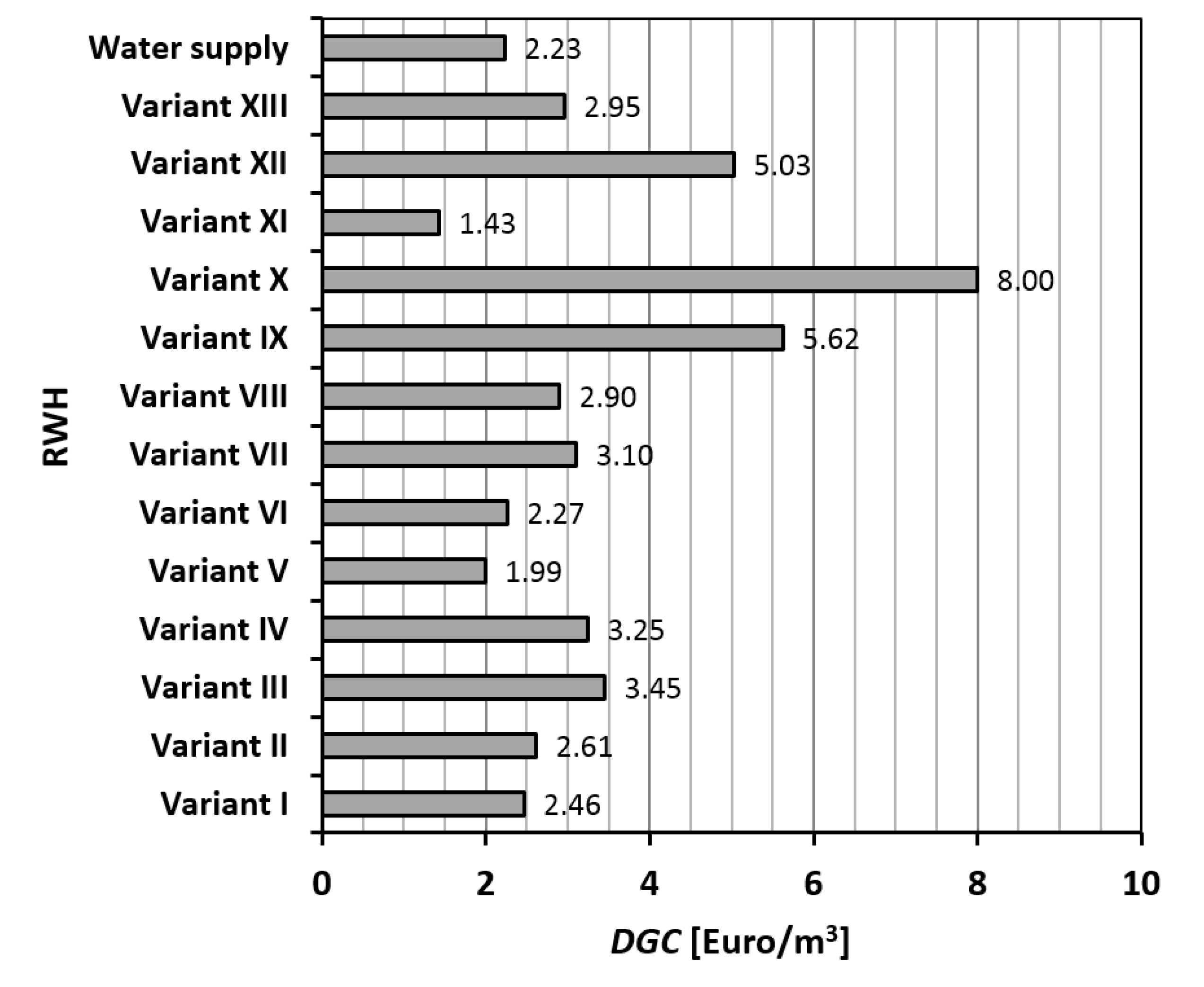
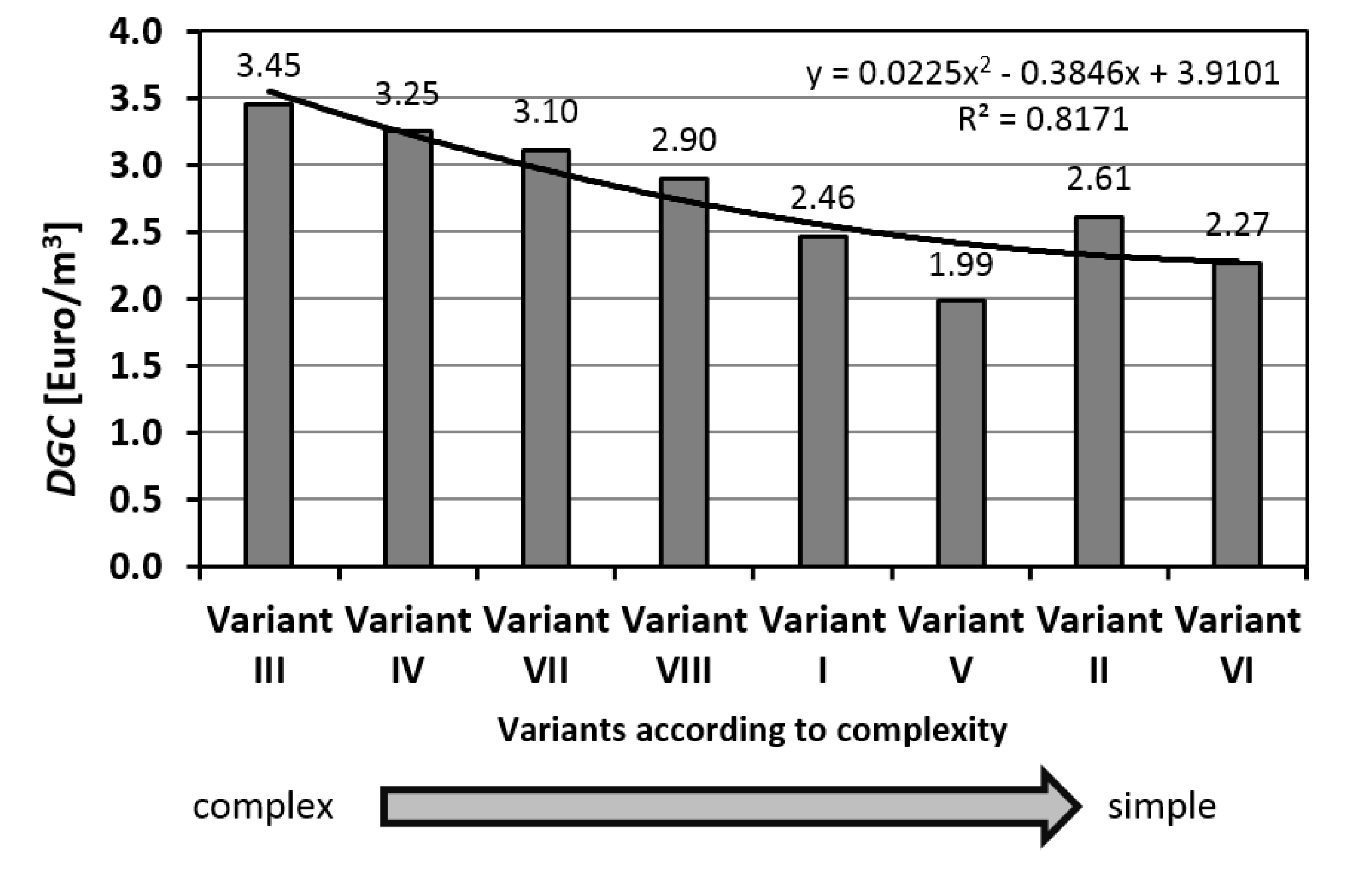
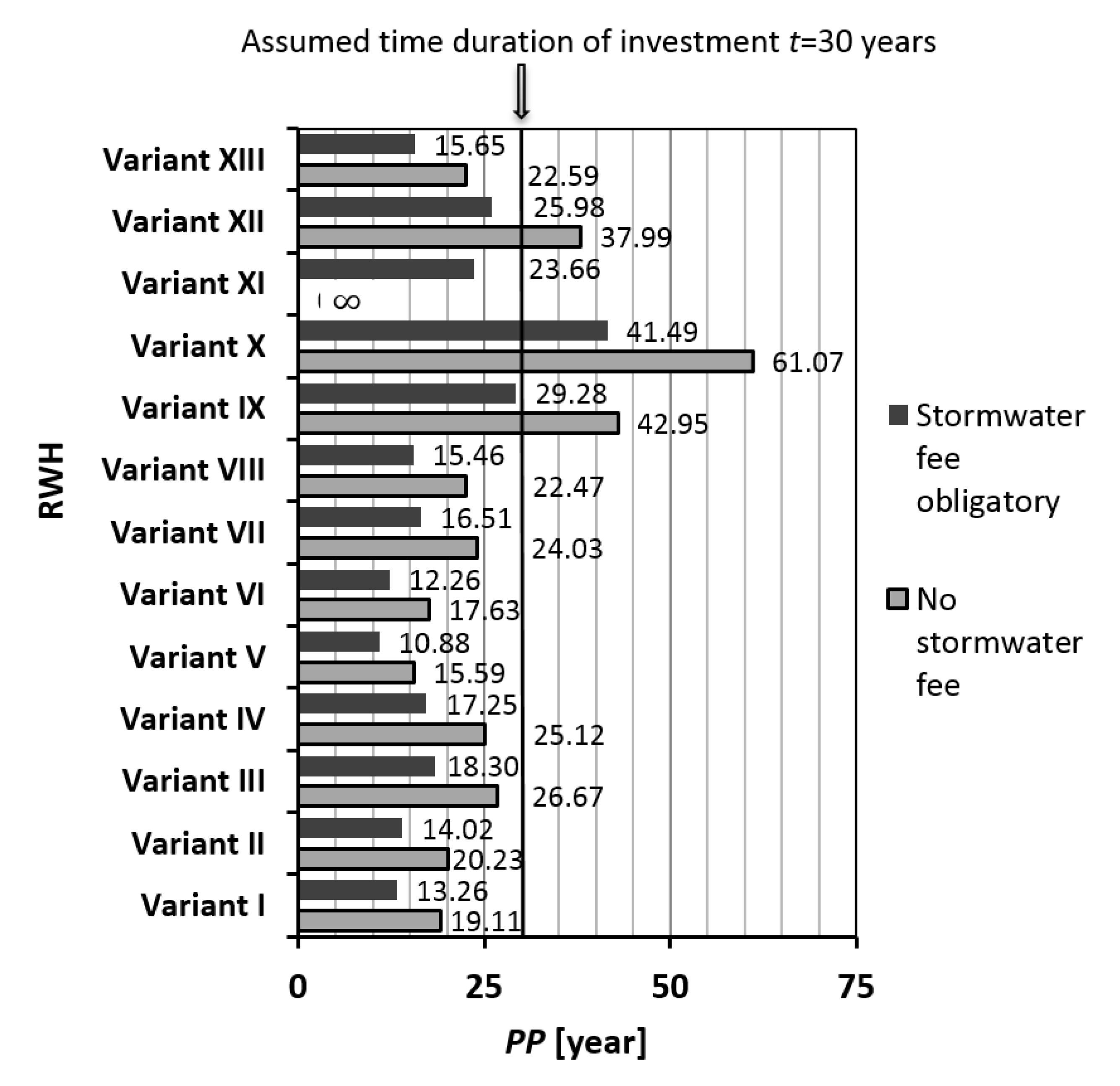
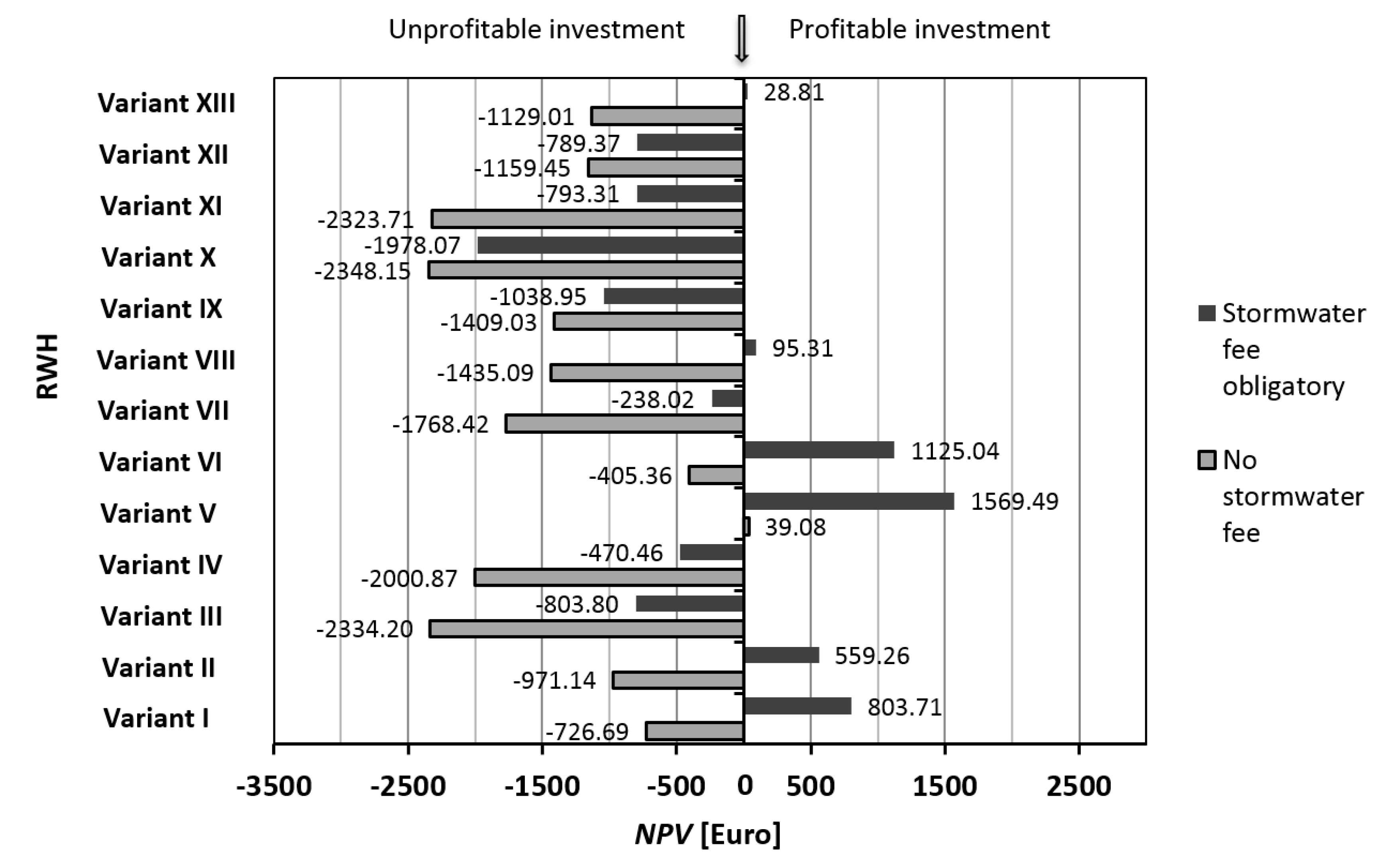
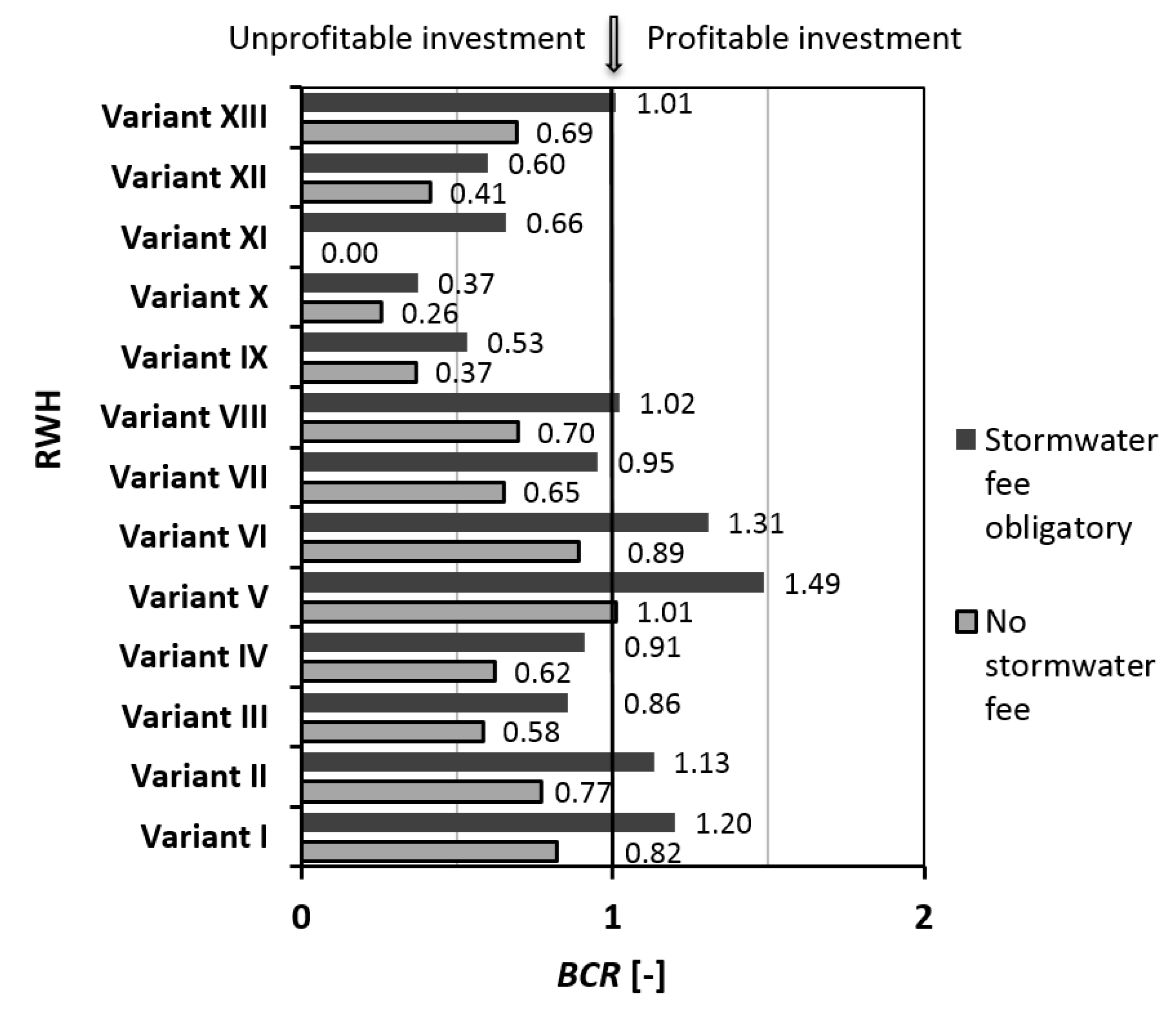
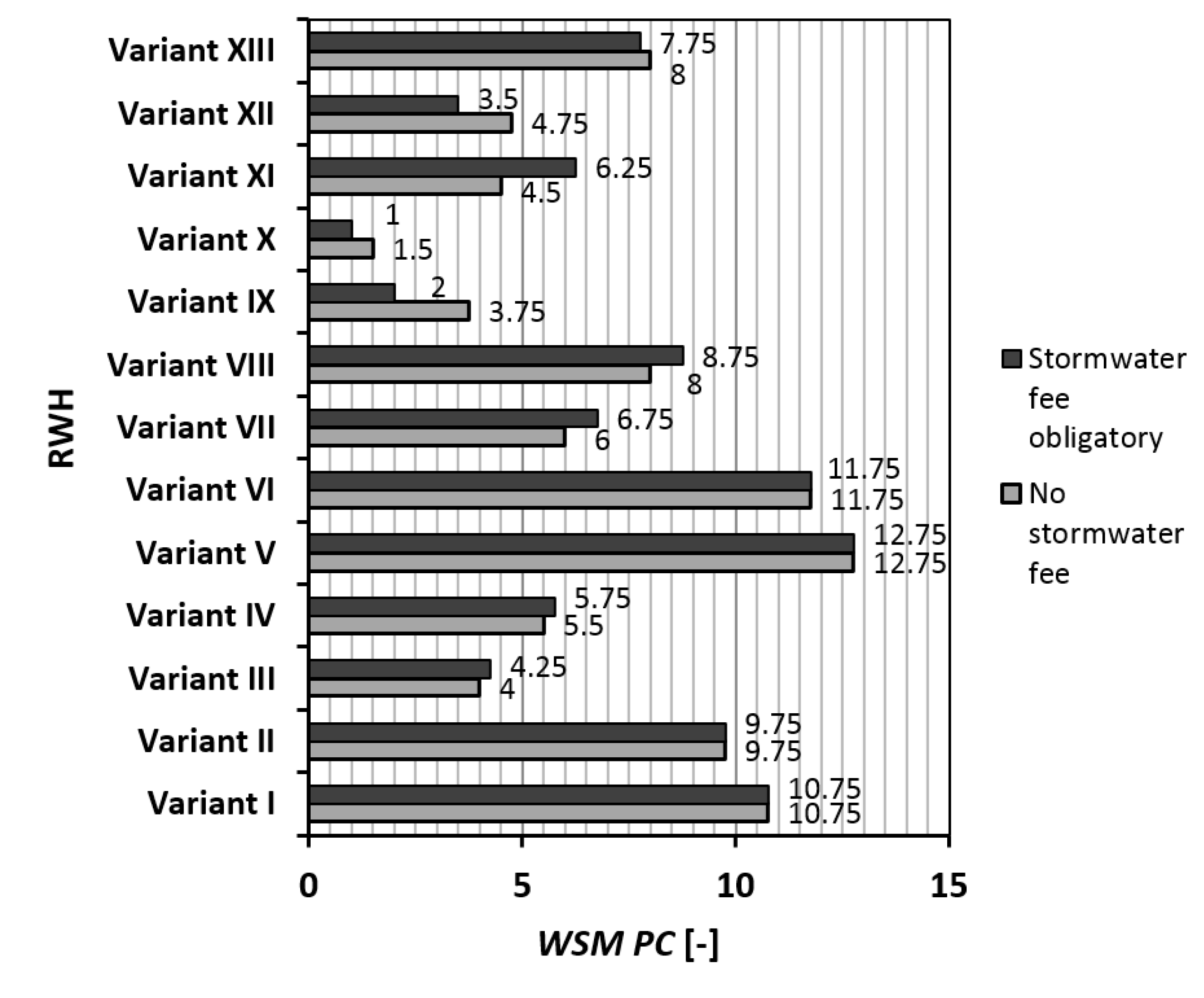
| Variant No. | Stormwater Tank | Pump | Filter | Central | Use of Rain Water | Reuse of Rain Water (m3/year) | |||||
|---|---|---|---|---|---|---|---|---|---|---|---|
| Under-Ground | Over-Ground | Internal | Downpipe | House | Garden | Car | Drainage | ||||
| I | + | − | + | + | − | − | + | + | + | − | 110 |
| II | + | − | + | − | + | − | + | + | + | − | 110 |
| III | + | − | − | + | − | + | + | + | + | − | 110 |
| IV | + | − | − | − | + | + | + | + | + | − | 110 |
| V | − | + | + | + | − | − | + | + | + | − | 110 |
| VI | − | + | + | − | + | − | + | + | + | − | 110 |
| VII | − | + | − | + | − | + | + | + | + | − | 110 |
| VIII | − | + | − | − | + | + | + | + | + | − | 110 |
| IX | − | + | + | − | + | − | − | + | + | − | 26.8 |
| X | − | + | + | − | + | − | − | + | + | + | 26.8 |
| XI | − | − | − | − | + | − | − | − | − | + | 0 |
| XII | − | + | − | − | + | − | − | + | + | − | 26.8 |
| XIII | + | − | + | + | − | − | + | − | − | − | 83.22 |
| Variant | Investment Costs (Euro) | Total O&M Costs (Euro) |
|---|---|---|
| I | 3938 | 126.6 |
| II | 4182 | 126.6 |
| III | 5493 | 232.1 |
| IV | 5160 | 232.1 |
| V | 3172 | 126.6 |
| VI | 3616 | 126.6 |
| VII | 4928 | 232.1 |
| VIII | 4594 | 232.1 |
| IX | 2174 | 103.8 |
| X | 3113 | 103.8 |
| XI | 2278 | 93.3 |
| XII | 1930 | 93.3 |
| XIII | 3571 | 116.1 |
| Tap water installation | 667 | 93.3 |
| Variant | I | II | III | IV | V | VI | VII | VIII | IX | X | XI | XII | XIII |
|---|---|---|---|---|---|---|---|---|---|---|---|---|---|
| Refund ratio [%] | 20 | 24 | 42 | 40 | 0 | 10 | 36 | 36 | 63 | 74 | - ** | 60 | 31 |
| Refund sum [Euro] | 787 | 1003 | 2307 | 2064 | 0 * | 361 | 1773 | 1653 | 1369 | 2303 | - ** | 1157 | 1107 |
| Available refundation programs | A, B | A, B *** | - | - | - | A, B | - | - | B *** | - | - | A, B | A, B |
© 2020 by the authors. Licensee MDPI, Basel, Switzerland. This article is an open access article distributed under the terms and conditions of the Creative Commons Attribution (CC BY) license (http://creativecommons.org/licenses/by/4.0/).
Share and Cite
Musz-Pomorska, A.; Widomski, M.K.; Gołębiowska, J. Financial Sustainability of Selected Rain Water Harvesting Systems for Single-Family House under Conditions of Eastern Poland. Sustainability 2020, 12, 4853. https://doi.org/10.3390/su12124853
Musz-Pomorska A, Widomski MK, Gołębiowska J. Financial Sustainability of Selected Rain Water Harvesting Systems for Single-Family House under Conditions of Eastern Poland. Sustainability. 2020; 12(12):4853. https://doi.org/10.3390/su12124853
Chicago/Turabian StyleMusz-Pomorska, Anna, Marcin K. Widomski, and Justyna Gołębiowska. 2020. "Financial Sustainability of Selected Rain Water Harvesting Systems for Single-Family House under Conditions of Eastern Poland" Sustainability 12, no. 12: 4853. https://doi.org/10.3390/su12124853
APA StyleMusz-Pomorska, A., Widomski, M. K., & Gołębiowska, J. (2020). Financial Sustainability of Selected Rain Water Harvesting Systems for Single-Family House under Conditions of Eastern Poland. Sustainability, 12(12), 4853. https://doi.org/10.3390/su12124853







